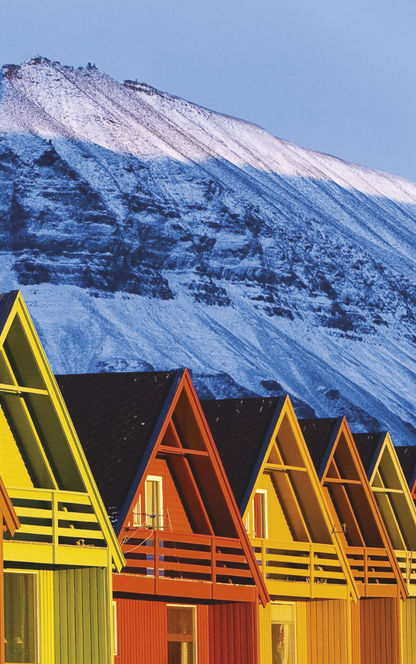Snowmobiling is an exciting way to discover Svalbard during the winter months. Whilst this tour isn’t technically demanding, it will take you through the varied terrain that makes driving fun! You will head through the winding Helvetiadalen and arrive at Elveneset where the valley opens into Sassenfjorden. From here you can see the mighty Tempelet Mountain across the water.
Svalbard’s impressive landscape will be surround you throughout the drive, and at the turning point, Elveneset, the guides will offer warm drinks and local stories before heading back to Longyearbyen.

Your holiday should feel like it’s been designed just for you. I’m here to make that happen with a personal touch and local insights.
-

Gallery
Snowmobile safari, Svalbard
-

Gallery
Snowmobile, Svalbard
Trip Ideas
-
 Offer Applies
Offer AppliesAround Spitsbergen
Arctic Small Ship CruiseVoyage along the Spitsbergen coast in search of polar bears and explorer history.
From £6773 Excluding Flights
Discover More7-13 Nights
Jun-Aug
-

Northern Lights 24-7 in Svalbard
Svalbard Short BreakWitness the northern lights day or night on this unique winter break in Longyearbyen, Svalbard.
From £487 Excluding Flights
Discover More3 Nights
Jan-Feb & Dec
-

Svalbard Summer Adventure
Svalbard IndependentExperience summer in the remote beauty of the High Arctic on this adventurous break based in Longyearbyen.
From £495
Discover More5 Nights
May-Oct
-

Svalbard Winter Adventure
Svalbard IndependentTravel to Longyearbyen for a unique winter experience as daylight returns to the high Arctic.
From £639
Discover More4 Nights
Feb-May
-
 Offer Applies
Offer AppliesWest Spitsbergen Explorer
Arctic Small Ship CruiseExperience the best of Spitsbergen's beautiful and rugged west coast as you search for wildlife and more.
From £5672 Excluding Flights
Discover More8-11 Nights
May-Aug
-

Scotland to Svalbard
Arctic Small Ship CruiseFollow in the wake of the Vikings as you cruise north past ancient sites and incredible scenery
From £7895 Excluding Flights
Discover More12-13 Nights
Apr-May
-
 Offer Applies
Offer AppliesSpitsbergen to East Greenland
Arctic Small Ship CruiseExperience three Arctic islands with magnificent scenery and a prolific array of wildlife
From £8636 Excluding Flights
Discover More12-24 Nights
Jul-Aug
-

Tromso and Svalbard
Norway IndependentImmerse yourself in beautiful Arctic scenery in two wonderful locations, often bathed in the northern lights.
From £625 Excluding Flights
Discover More6 Nights
Jan-May & Nov-Dec
Blogs
-
 Offer Applies
Offer AppliesAround Spitsbergen
Arctic Small Ship CruiseVoyage along the Spitsbergen coast in search of polar bears and explorer history.
From £6773 Excluding Flights
Discover More7-13 Nights
Jun-Aug
-

Northern Lights 24-7 in Svalbard
Svalbard Short BreakWitness the northern lights day or night on this unique winter break in Longyearbyen, Svalbard.
From £487 Excluding Flights
Discover More3 Nights
Jan-Feb & Dec
-

Svalbard Summer Adventure
Svalbard IndependentExperience summer in the remote beauty of the High Arctic on this adventurous break based in Longyearbyen.
From £495
Discover More5 Nights
May-Oct
-

Svalbard Winter Adventure
Svalbard IndependentTravel to Longyearbyen for a unique winter experience as daylight returns to the high Arctic.
From £639
Discover More4 Nights
Feb-May
-
 Offer Applies
Offer AppliesWest Spitsbergen Explorer
Arctic Small Ship CruiseExperience the best of Spitsbergen's beautiful and rugged west coast as you search for wildlife and more.
From £5672 Excluding Flights
Discover More8-11 Nights
May-Aug
-

Scotland to Svalbard
Arctic Small Ship CruiseFollow in the wake of the Vikings as you cruise north past ancient sites and incredible scenery
From £7895 Excluding Flights
Discover More12-13 Nights
Apr-May
-
 Offer Applies
Offer AppliesSpitsbergen to East Greenland
Arctic Small Ship CruiseExperience three Arctic islands with magnificent scenery and a prolific array of wildlife
From £8636 Excluding Flights
Discover More12-24 Nights
Jul-Aug
-

Tromso and Svalbard
Norway IndependentImmerse yourself in beautiful Arctic scenery in two wonderful locations, often bathed in the northern lights.
From £625 Excluding Flights
Discover More6 Nights
Jan-May & Nov-Dec
























